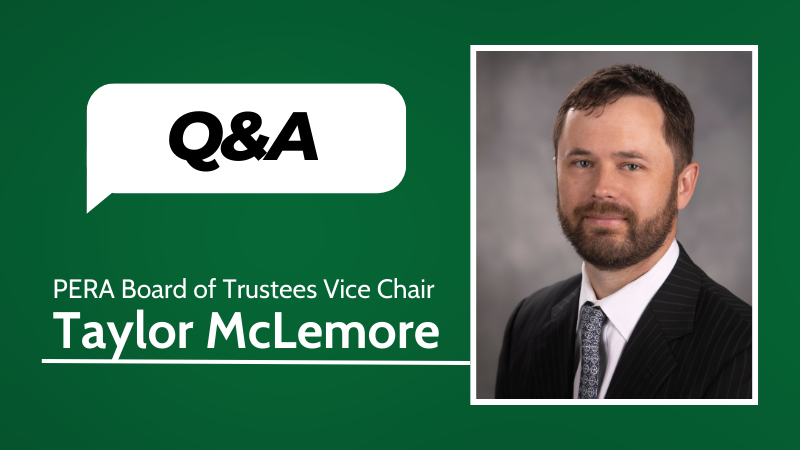Every year, the actuarial consulting firm retained by the Colorado PERA Board of Trustees performs an actuarial valuation. An actuarial valuation is an estimate of the cost of providing retirement benefits to current and future retirees in the system. This analysis requires the use of a variety of assumptions that represent the best estimates of the future, using both demographic and economic assumptions. Because the assumptions are predictions of the future using mathematical modeling, they are a blend of both art and science.
PERA’s Board of Trustees has a fiduciary duty to select assumptions that will fall within a range of probable outcomes over time. There are two types of assumptions – demographic and economic – that are both long-term in nature but vary from over time. While the most powerful assumption in PERA’s actuarial valuation is the investment return, other assumptions factor into the final funded status result provided by the valuation. The funded status provides a ratio of the plan’s current and future assets to its current and future liabilities. It is a measure of the fund’s current assets compared to the net present value of expected future liabilities driven by the benefit payment estimates.
Demographic assumptions used by PERA’s actuaries attempt to estimate the answers to the following questions:
- How many members will leave PERA-covered employment?
- How many members will retire with a disability?
- How many members will retire?
- What will active member salary increases be?
- How many members with more than five years of service credit will refund their accounts?
- At what age will members with more than five years of service credit retire?
- How many members will die before retiring?
- How long will members/retirees live?
Every few years, these demographic variables are reviewed so adjustments can be made to reflect what actually happened and adjust estimates for the future. These adjustments are what actuaries call gains and losses.
Once all the various demographic factors are assessed and aggregated, they are used to calculate what the retirement system owes to members in the plan now and into the future. This amount, also known as PERA’s total liabilities, reflects the value of all current and future benefits payable to members. Keep in mind that not all benefits are due and payable at once.
Economic assumptions are used to calculate the current and future value of all PERA assets which will be measured against the liabilities to determine a funded percentage (status). Economic assumptions used by PERA include:
- Price inflation;
- Wage inflation; and
- Investment return.
These variables are compared to recent experience and rely on both long-term historical information and expected future investment performance.
The long-term rate of return assumption, as mentioned previously, is the most powerful of all the assumptions used and therefore it receives a lot of attention. According to the National Association of State Retirement Administrators (NASRA), “many public pension plans have reduced their return assumption in recent years. Among the 127 plans measured, more than one-half have reduced their investment return assumption since fiscal year 2008. The average return assumption is 7.62 percent.”
Details on the long-term rate of return assumption and the rates other public pension systems in the country use may be found in the 2016 NASRA Issue Brief on public pension plan investment return assumptions.
Once the economic assumptions are set, they are applied to the expected liabilities in the PERA trusts to determine their present value. This amount is compared to the value of assets currently in the trusts in order to determine a funded ratio. Then the actuaries calculate the number of years it will take for assets to match liabilities based upon future asset performance and contributions. The result of this calculation is the amortization period. PERA’s funded status at the end of 2015 was 62 percent based on the actuarial value of assets. At the end of 2015, the time required to reach full funding for PERA’s large division trust funds, or the amortization period, was approximately 44 years.
The PERA Board is slated to review and possibly adjust the economic and demographic assumptions at the November 18 meeting.
Read more about what actuaries do and about PERA’s best actuarial practices.
PERA on the Issues posts are written and compiled by the staff of Colorado PERA under the direction of Executive Director Greg Smith and the PERA Board of Trustees.
We encourage you to comment with your thoughts and feedback.
Trust fundA fund in which money and/or other assets are held and managed by trustees on behalf of plan participants. PERA maintains trust funds for each of its Defined Benefit Plan divisions (State, Local Government, School, Denver Public Schools, and Judicial).FiduciaryA person who manages money on someone else’s behalf and who has a sworn responsibility to manage those funds in the best interest of the client. Actuarial valuationAn annual assessment of a pension plan’s finances and membership. This forms the backbone of the plan’s annual financial report.ActuaryA highly skilled mathematician who helps pension plans, insurance companies, and other financial institutions plan for the future based on historical and anticipated data.AmortizationThe act of paying down debt or liabilities over time.





I would like a comment or two regarding the 2% we get annually if the interest rates rise like they are being bantered around and we lose needed dollars to live on.
Mr. Steiner,
Thank you for your question. As part of the shared sacrifice approach to the reforms contained in SB 1, retirees did their part to ensure the long-term sustainability of PERA with the reduction in the Annual Increase. Active employees and employers also shared in the sacrifice. The good news is that our retirees have kept up with inflation in the five years following the passage SB 1, and PERA is now sustainable. The PERA Board and Legislature will continue to monitor the effects of the reduction to the Annual Increase on our retirees and also ensure PERA remains sustainable for both today’s retirees and future retirees.
What is PERA’s current return on its investments at this point for the year 2018? And, how did we do last year, 2017?